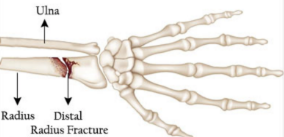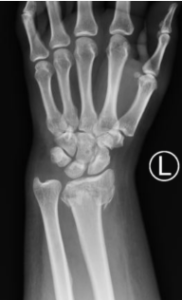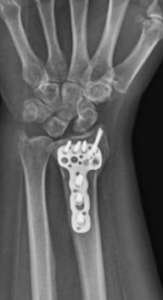Distal Radius Fracture
What is a Distal Radius Fracture?
A distal radius fracture is a break of the larger bone of the wrist. This can occur in patients of all ages from a variety of traumatic causes. It is a very common injury. The bone can break in many different ways and can range in severity. Sometimes the bone breaks and sticks out through the skin. This is called an open fracture and needs urgent surgery. Other types of distal radius fractures include intra articular, extra-articular, simple and comminuted fractures. Each requires specific types of treatments so it is important for your doctor to diagnose and treat your injury appropriately.

Illustration of distal radius.
Reproduced with permission from OrthoInfo. © American Academy of Orthopaedic
Surgeons. https://orthoinfo.org/
What Does the Distal Radius do?
The distal radius is the largest support bone of the wrist. All the wrist bones are important for function and their shape and position must be perfect to allow for full wrist range of motion. The distal radius does have a cartilage joint surface that helps the wrist joint glide smoothly. If this becomes uneven wrist arthritis can occur.
How is a Distal Radius Fracture Diagnosed?
To diagnose a distal radius fracture, your doctor may use a physical examination and imaging tests. Physical examination is important in the evaluation of these injuries. Important blood vessels and nerves lie near the distal radius and can be injured when it breaks. Sometimes patients with wrist fractures can develop acute carpal tunnel syndrome with numbness in the thumb, index and middle fingers. This requires urgent treatment. The doctor will also look for any open wounds over the injury. Sometimes the bone pushes against the skin causing it to “tent.” Too much pressure can result in the bone coming through the skin.
X-rays are used to evaluate the location, type, and severity of the broken bone. This helps doctors and patients make an informed decision on treatment. Often 3 or more x-rays are taken to show the injury pattern. In cases where there are many pieces or severe intra articular fractures, a CT(Computed Tomography) Scan is ordered to help guide surgical treatment.

Preoperative x-ray of distal radius fracture.
Broken Wrist Treatment
Surgery for distal radius fractures may be required depending on the severity of break, location of the affected area and whether or not the fracture is displaced. If the break is minor, non-surgical treatment may be recommended.
Non-Surgical Treatment
Distal radius fractures do not always require surgery. Many heal just fine without an operation. Minor fractures with minimal displacement do very well with nonsurgical treatment. Other displaced fractures can be “reduced” and casted. This means the doctor can push the bones back in place. Initially, splints are placed in the emergency room and converted to casts in the orthopedic office.
If non-operative care is chosen, regular follow-up care for a physical exam and x-rays is important to ensure that the fracture stays in good position and heals appropriately. Cutting down or quitting smoking and tight blood sugar control if you are a diabetic is important for the healing process. If the bones loses alignment or slips, surgery may be required.
Broken wrists treated non-operatively are usually casted for 6 weeks. The cast is then removed, patients are given a removable wrist brace and physical therapy is started to help patients regain their range of motion.
Surgical Treatment
Surgeons may recommend an operation to fix the broken wrist if it is broken into many pieces, if the bones are far apart, if the joint is uneven, if the bone sticks out through the skin, or if the nerves or blood vessels are injured. Several studies have shown that surgery helps reduce pain, get people back to work sooner and maintains shoulder strength and motion.
Distal radius fractures can be fixed with plates and screws or pins. Plates and screws require bigger incisions but ensure that the bone is lined up perfectly. Pins use smaller incisions and are usually used for less serious injuries or in kids with wrist fractures. Surgery takes under an hour and can often be done on a “same day” or outpatient basis. Ideally, surgeons like to perform surgery within 1-2 weeks of injury. Thus, patients have time to seek a second opinion regarding treatment if more information or additional surgeon input is desired.
In cases where there is severe injury to the muscles, nerves or arteries or there is significant contamination with dirt, rocks or grass from the injury, some patient require external fixation prior to definitive surgical treatment. This is an operation where metal pins are placed into the bone through small cuts and connected to bars to give some stability to the bone. After secondary operations to clean the wound or recovery of skin injuries, the external fixator can be removed and plates and screws can be placed.

Postoperative x-ray of distal radius fracture repair.
Why Choose ROC for Your Broken Wrist Surgery?
It is important to choose your surgeon wisely. Extensive surgical experience can be helpful in achieving a good result and avoiding complications. Collectively, ROC trauma and hand orthopedic surgeons have performed more wrist operations than any practice in Northern Nevada and take pride in outstanding surgical results.
After surgery, patients are placed in a splint and given a sling for comfort only. Weight-bearing is limited to a few pounds but patients have their fingers free to type and perform gentle activities. In 10 to 14 days, the splint is removed, a removable brace is used and initial range-of-motion exercises are encouraged. Some patients are referred to physical and occupational therapy to help with stiffness, strengthening and motion.
Postoperative X-Ray of Distal Radius Fracture
Complications After Broken Wrist Surgery
Complications can occur following broken wrist surgery. Some of the risks and complications include:
- Infection is a common risk following any surgery. A dose of antibiotics given prior to surgery helps to make this risk as small as possible.
- Injury to blood vessels or nerves may occur. This is reduced by having an experienced surgeon involved in your care.
- Bones may not heal properly from patient noncompliance, diabetes, or use of nicotine like smoking and chewing tobacco. If this occurs, secondary surgery may be required.
- Reflex Sympathetic Dystrophy (RSD) or Complex Regional Pain Syndrome (CRPS) is a rare complication of broken wrist surgery. This is a condition where patients develop unrelenting pain and hypersensitivity. This can be treated with physical therapy, nerve blocks and medication.
Broken Wrist Recovery
Most people with wrist fractures do very well. By 6 weeks, patients are extremely comfortable and usually are released to full activities such as manual labor, skiing and motocross by 3 months. Aggressive return to activity too early can result in re-fracture, hardware breakage or nonunion. If you have had surgery, sometimes the metal becomes painful. This can be removed one year after surgery.
In need of an orthopedic specialist? Schedule an appointment with one of our specialty-trained Trauma and Fracture doctors to talk through your options. Reno Orthopedic Clinic offers comprehensive treatment for a full range of traumatic injuries at multiple convenient locations in Reno, Sparks and Carson City.

